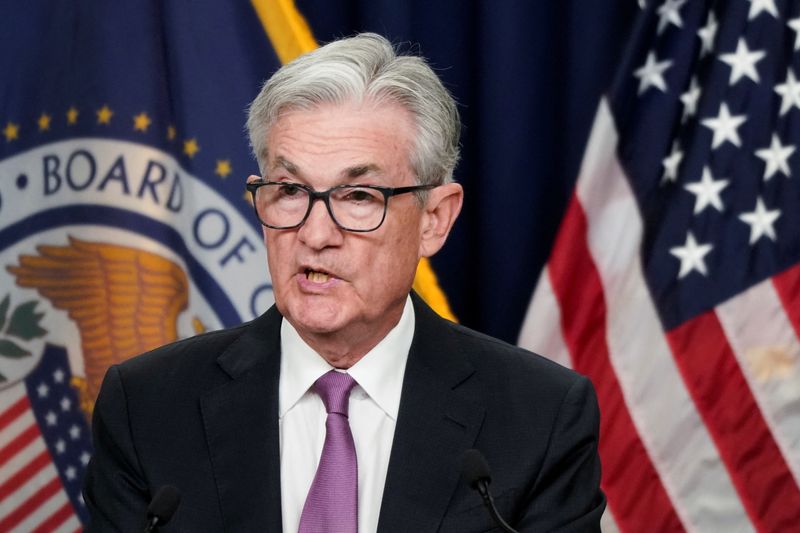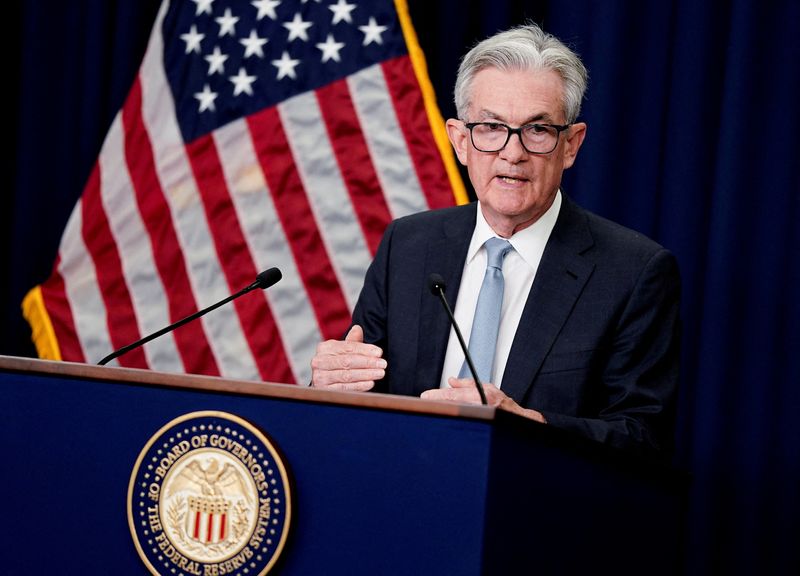By Howard Schneider and Ann Saphir
WASHINGTON (Reuters) -The Federal Reserve said on Wednesday it would not flinch in its battle against the most intense breakout of inflation in the United States since the 1980s even if that means a "sustained period" of economic weakness and a slowing jobs market.
As he explained the logic behind the stiffest interest rate increases in roughly four decades, Fed Chair Jerome Powell was peppered with questions about whether the U.S. economy was in or on the cusp of a recession - a notion he rejected because U.S. firms continue to hire in excess of 350,000 additional workers each month.
"I do not think the U.S. is currently in a recession," he told reporters after the end of the U.S. central bank's latest policy meeting, citing an unemployment rate that is still near a half-century low and solid wage growth and job gains. "It doesn't make sense that the U.S. would be in recession."
But the 75-basis-point rate increase announced by the Fed on Wednesday, coupled with earlier actions in March, May and June, has now jacked the central bank's overnight interest rate from near zero to a level between 2.25% and 2.50%. That is the fastest tightening of monetary policy since former Fed Chair Paul Volcker battled double-digit inflation in the 1980s.
The cure then involved back-to-back recessions.
Consumer prices haven't yet breached the 10% annual mark this time - but at 9.1% they are close enough to raise the stakes for both the Fed and the Biden administration, which is particularly sensitive on the issue ahead of congressional elections in November.
While Powell said he did not think a recession would be needed to fix the problem this time, he acknowledged that the economy was slowing and would likely need to slow more for the Fed to bring the pace of price increases back to earth.
"We do want to see demand running below potential for a sustained period to create slack" in the economy, Powell said in a news conference. "We're trying to do just the right amount. We're not trying to have a recession."
But he was adamant that the behavior of inflation would drive the Fed's course, and that "another unusually large (rate) increase could be appropriate" when the Fed next meets if inflation does not begin to slow.
Powell, and many of his Fed colleagues, have been caught out this year making policy commitments based on data - particularly on inflation - that has surprised them in negative ways and forced them to adjust on the fly.
The Fed chief offered little specific guidance about what to expect next, a fact that puts a heavy focus on two months of upcoming data. The Fed's usual six-week interlude between policy meetings is eight weeks this time, providing what Powell called "quite a lot of data" to digest, including July and August inflation readings that will either show evidence of slowing price increases - or not.
"Restoring price stability is just something we have got to do," Powell said. "There isn't an option to fail."
When measured by the Fed's preferred gauge, inflation is running at more than three times the central bank's 2% target.
Fed officials are "acutely aware" of the hardship that inflation imposes on American households, particularly for those with limited means, Powell said, and they will not relent in their effort until presented with "compelling evidence" that inflation is coming down.
While jobs gains have remained "robust," officials noted in the new policy statement that "recent indicators of spending and production have softened," a nod to the fact that the aggressive rate hikes they have put in place since March are beginning to bite.
DATA-DEPENDENT
New data due to be released on Friday will show to what extent growth slowed in the second quarter.
Powell said some of the impact of Fed rate increases to date is still building in the economy, and depending on how inflation responds in coming months that could allow the central bank to begin to slow the pace of rate increases.
The policy rate is now at the level most Fed officials feel has a neutral economic impact, in effect marking the end of pandemic-era efforts to encourage household and business spending with cheap money. The rate also matches the high point of the central bank's previous tightening cycle from late 2015 to late 2018, a level reached this time in the span of just four months.
Investors expect the Fed to raise its policy rate by at least half a percentage point at its Sept. 20-21 meeting.
"While another unusually large increase could be appropriate at our next meeting, that is a decision that will depend on the data we get between now and then," Powell said. "We will continue to make our decisions meeting by meeting, and communicate our thinking as clearly as possible."
Futures markets tied to Fed policy expectations tilted somewhat back toward a more moderate increase for the next meeting as Powell spoke on Wednesday.
In the U.S. Treasury market, which plays a key role in the transmission of Fed policy decisions into the real economy, yields on the 2-year note moved lower. The yield on the 10-year note was little changed.

Stocks on Wall Street added to broad gains in the session, with the S&P 500 index closing 2.6% higher, while the dollar weakened against a basket of major trading partners' currencies.
"From here, it is possible that the Fed slows its tightening pace, reassured by the likely peaking of inflation and pullback in inflation expectations as oil prices have fallen," Seema Shah, chief global strategist at Principal Global Investors, said in a note. "However, with the labor market still a picture of strength, wage growth still uncomfortably high and core inflation set to decline at a glacially slow pace, the Fed certainly cannot stop tightening, nor can it down shift gears too much."
